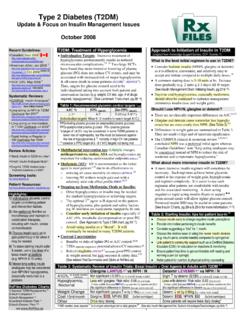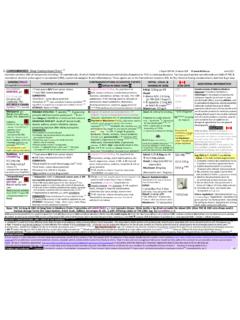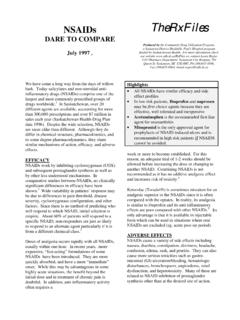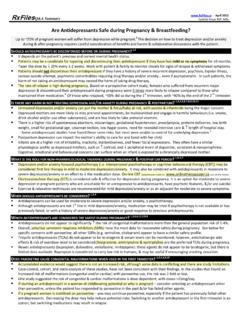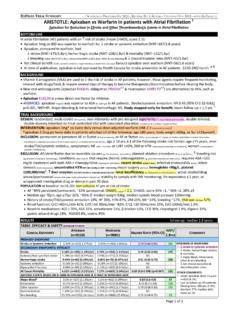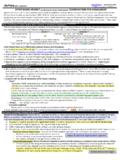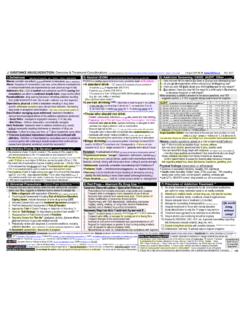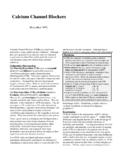Transcription of H. pylori Eradication Regimens - RxFiles
1 H. pylori Eradication Regimens1-2-3 CuredMarch 1999 Highlights H. pylori Eradication drastically reduces ulcerrecurrence in patients with duodenal or gastric ulcers. 7-day triple therapies with a proton pump inhibitor(PPI) + two antibiotics given BID are currentlyrecommended first-line for H. pylori lansoprazole (or alternate PPI) + clarithromycin + either metronidazole or amoxicillin (see Table 3) A dose of clarithromycin 250mg po BID is preferredwhen using in combination with a PPI andmetronidazole; however, the 500mg po BID dose isrecommended in combination with a PPI + amoxicillin. Maintenance acid suppression therapy is not necessaryfollowing H. pylori Eradication except in high-riskpatients ( severe GI bleed; refractory ulcer disease). Ranitidine Bismuth Citrate or RBC (Pylorid ) is a newagent useful in H. pylori Eradication Regimens . Background Helicobacter pylori is an important cause of duodenal andgastric ulcers. Greater than 90% of duodenal ulcers and 70%of gastric ulcers are associated with H.
2 Eradicationof H. pylori is effective in healing ulcers and drasticallyreducing the ulcer recurrence, eliminating the need formaintenance H. pylori is a gram negative bacillus which colonizes in thegastric mucosa and causes an increase in gastrin release. stimulates an inflammatory response involving therelease of chemotactic cytokines such as Besides being a major etiological factor in peptic ulcerdisease (PUD), there is some evidence that it may also beassociated with other gastric H. pylori is not easyto eradicate. Factors such as the bacterial resistance anddifficulty achieving bactericidal concentrations in the gastricmucosa contribute to the variable response to antibiotictherapy. As a result, triple and quadruple pharmacotherapyregimens are now used to ensure high Eradication rates. Indications for H. pylori Eradication The most recent Canadian H. pylori Consensus Conferencerecommends that "all H. pylori -positive patients with anunequivocal duodenal or gastric ulcer, whether active orinactive, should receive Eradication treatment.
3 Even ifNSAIDs are the suspected etiological agent, Eradication ofdocumented H. pylori infection is appropriate".4 TheConsensus Conference discussed various other indicationsfor H. pylori Eradication therapy and the reader is referred tothe document for a complete discussion of this area. H. pylori - Treatment Options First-line Eradication Regimens achieve high rates ofboth Eradication and patient compliance. Two triple therapy- 7 day Regimens are currently accepted as first-line therapy(see Table 3).4 They combine a proton pump inhibitor (PPI)with either metronidazole and clarithromycin (Biaxin ), oramoxicillin and clarithromycin. These Regimens generallyachieve Eradication rates of >80% on an intention-to-treatanalysis (ITT) and >90% on a per-protocol analysis (PP).Since non-compliance can drastically reduce Eradication rates, twice daily administration schedules are approach is sometimes referred to as '1,2,3' - one week,twice a day, with three medications. Second-line Eradication Regimens include quadrupletherapy with bismuth, metronidazole, and tetracycline pluseither a PPI or an H2 receptor antagonist (H2RA) (see Table3).
4 4 If a PPI is chosen, the regimen can be given for 7 days;however, if an H2RA is used, 14 days are therapies are considered second-line because theregimens require a more complex administration schedule( QID) and may be less well tolerated. Quadrupletherapies are therefore usually reserved for patients whohave failed one or more courses of triple therapy. 4,5 Somequadruple therapies are less costly and appropriate forpatients in whom cost is a significant factor. Pylorid is a new drug which consists of ranitidinebismuth citrate (RBC) 400mg. It may be useful in second-line triple therapy Regimens when combined with twoantibiotics (see Table 1). RBC was not included inrecommendations from the last Canadian ConsensusConference as it was not yet on the market. It has shownsimilar efficacy to PPI's in 7 day - triple therapy Regimens (see also Table 1). Further studies are awaited to verifyefficacy compared to PPI-triple therapy in Choosing a Regimen If the patient has a penicillin allergy, amoxicillin-containing Regimens must be avoided.
5 Amoxicillin regimensmay also be less effective in patients pretreated with PPI' If the patient has previously been on metronidazole, or isnot willing to give up alcohol for the 7 day therapy, a non-metronidazole regimen may be preferred. If cost is a significant concern, a low-cost regimen such asRBC (Pylorid ) + metronidazole + tetracycline appears tooffer Eradication rates similar to first-line PPI triple therapyat a cost of ~ $45 for 7-day therapy. (Although H. pylorieradication is expensive, it consistently results in lower costsand better outcomes than H2RA maintenance ,7) If compliance is a major concern, the HP-Pack (see Table3) offers the advantage of a convenient blister card. Eachcard provides one day's therapy, with morning and eveningdosing clearly indicated. If a patient is on phenytoin, diazepam, warfarin,theophylline or other drugs metabolized by CYP-2C9 orCYP-2D6, pantoprazole (Pantoloc ) may be the preferredPPI. Omeprazole is thought to be most likely, andpantoprazole least likely, to have CYP450 related druginteractions, although the significance appears to Clarithromycin has more significant potential fordrug interactions with various agents as listed in Table Up Acid SuppressionRecurrence of ulcers following H.
6 pylori Eradication areuncommon. One prospective study which followed 141duodenal ulcer and 45 gastric ulcer patients for yearsfound no ulcer recurrence after H. pylori Eradication inpatients not taking ASA or Thus, most patientsdo not require further acid suppression treatmentfollowing H. pylori Eradication . Additional short term acidsuppression with PPI's or H2RA's may be indicated insymptomatic Complicated patients with large, orrefractory ulcers, should receive acid suppression treatmentuntil ulcer healing and H. pylori Eradication can In the case of gastric ulceration, follow-up isimportant in ensuring complete ulcer healing, and excludingthe possibility of malignancy. Upon Eradication of H. pyloriand completion of ulcer healing, maintenance therapy is onlyindicated in patients at high risk for recurrence of bleeding( need for continued ASA/NSAID therapy; high acid-secretory condition ).Related QuestionsWhat do we know about the relative efficacies of thevarious Eradication Regimens ?
7 It is difficult to compare Eradication rates reported fromdifferent studies. There are many variables that can affectthese rates. It has been suggested that the intention-to-treat(ITT) rather than the per-protocol (PP) analysis should beused as the primary Few definitive head to headstudies have been performed, and given the relatively higheradication rates currently achieved with triple therapies,studies showing significant differences are are the rates of H. pylori resistance in Canada? H. pylori resistance to metronidazole ranges from 11% to38%. However, when metronidazole is used in regimenswith bismuth subsalicylate (BSS) or clarithromycin, they areoften still highly effective even if H. pylori appears to bemetronidazole Primary resistance of H. pylori to clarithromycin is lowgenerally less than 2%.11,12 Acquired resistance canapproach 6%, reinforcing the recommendation to use triplerather than dual clarithromycin 250mg as good as 500mg in the PPI-triple based Regimens ?
8 When used in combination with a PPI and metronidazole,clarithromycin should be given as 250mg po This issupported by the MACH I Study which found thateradication rates were higher with the 250mg dose ofclarithromycin than they were with the 500mg dose (90%versus 84% respectively).14 The lower dose is also bettertolerated and less costly. When given with a PPI and amoxicillin, the currentrecommendations are to use 500mg clarithromycin po this dose offers additional benefit is uncertain. Inthe MACH I study, the higher clarithromycin dose wassuperior to the low dose14; however, several studies haveused doses of clarithromycin 250mg po BID whilemaintaining Eradication rates >85% ,16,17 Unlesspatient tolerance or cost are significant concerns, the 500mgmg dose of clarithromycin is recommended for PPI tripletherapy with there any rational for selecting one PPI over another? Studies to date suggest that omeprazole 20mg BID,lansoprazole 30mg BID, and pantoprazole 40mg BID havecomparable efficacy in H.
9 pylori ,16 ,18,19 Mostcontrolled studies have used either omeprazole orlansoprazole. Currently, lansoprazole may be preferred. Ithas shown more potent inhibition of H. pylori ureaseactivity,20 is generally less costly, and has less potential fordrug interactions than if a triple therapy fails? Although routine documentation of H. pylori Eradication isnot recommended in uncomplicated ulcer patients, arecurrence of ulcer symptoms warrants a reassessment of Endoscopy and biopsy or a urea breath testmay be performed at least four weeks after Eradication , andseven days after stopping acid suppressive assays are inappropriate as they remain high forseveral months following successful Eradication . Retreatment should usually be attempted with differentantibiotics than were originally Resistance isespecially a concern with metronidazole and rarely withclarithromycin. Alternative therapy with a quadrupleregimen ( PPI, BSS, metronidazole, and tetracycline) 11or a triple regimen with RBC (Pylorid ) may be considered(see Table 3).
10 Is classical triple therapy with bismuth, metronidazoleand tetracycline still an option? This triple regimen was not recommended by the CanadianConsensus Conference because a meta-analysis showed thaton an ITT analysis, it had an Eradication rate of ~78%, belowthe arbitrary 80% cut-off available on request The Rx Files: H. pylori Eradication Supplementary Tables Table 1 Ranitidine bismuth citrate (RBC) (Pylorid )Description: A salt complex resulting from a direct reaction betweenranitidine and bismuth citrate. Each 400mg tabletcontains 162mg of ranitidine base, 128mg trivalentbismuth, and 110mg of Effective in the treatment of H. pylori when used incombination with (Pylorid ) Combination Regimens : Pylorid 400mg po BID + tetracyline 500mg po QID +metronidazole 500mg po TID x 7 days22 Eradicationrates: 86% (ITT) Pylorid 400mg + clarithromycin 500mg + amoxicillin1000mg po BID x 7 days22 Eradication rates: 92% (ITT) Pylorid 400mg + clarithromycin (Biaxin ) 500mg poBID x 14 days22,21 Eradication rates: 82-95% (ITT)Adverse Effects & Drug Interactions23 Diarrhea, the only adverse effect seen in >1% ofpatients.
